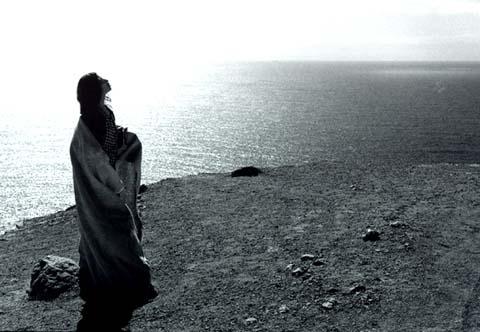Cinema did not take long to arrive in Brazil. Seven months after the first session put on by the Lumière brothers in Paris, that is to say on the 8th of July 1896, the inhabitants of Rio de Janeiro were treated to a crude imitation of the cinematographer, in the busiest and most novelty-seeking street in the center of Rio, the Ouvidor. The first images created here with a camera date from June of 1898. They focused on the bay of Guanabara and some vessels anchored there. The man with his eye to the viewfinder was an Italian immigrant named Afonso Segreto, who was arriving from Europe with his first Lumière camera.
For a time, Afonso and his brother Paschoal held the monopoly of moving pictures here in Brazil. At the beginning of this century immigrants like the Segretos started the competition in movie making in Brazil. One of them, Guiseppe Filipi, established himself in Curitiba and later in Porto Alegre. From 1905 on, the Portuguese Antônio Leal specialized in recording fait divers (various happenings) and popular celebrations in Rio. The creator of our first chain of moving picture theaters, Francisco Serrador, was of Spanish blood.
Films with a plot were only made from 1908 on. Films in this vein started with a comedy, Nhô Anastácio Chegou de Viagem (Mr. Anastácio has arrived from his travels), by Júlio Ferrez. Antonio Campos, influenced by the Frenchman Georges Méliès, filmed O Diabo (The Devil), also a pioneering film, with special effects. Antônio Leal, enthusiastic about the possibilities offered by cinematography of creating a fantasy world, changed the documentary into fiction. He adapted O Guarani (an indigenous tribe), by José de Alencar, and with Os Estranguladores (the Stranglers), he discovered a rich vein which became fashionable in Rio for some time: films of medium length dramatizing lurid stories from the police records of the time. He ended up being defeated in this field by Alberto Botelho, who made O Crime da Mala (The Suitcase Crime) into the first box-office hit of the Brazilian cinema.
The cinema fever infected nearly the whole country. Paulo Benedetti carried it as far as Barbacena; Anibal Requião, to Curitiba; Aristides Junqueira, to Belo Horizonte; Diomedes Gramacho, to Salvador. However, Rio de Janeiro and São Paulo continued to be the most exuberant production centres – and the most aware of the novelties from abroad. In our enthusiasm in imitating them, we produced as many as three versions of A Viúva Alegre (The Merry Widow) and one of A Cabana do Pai Thomás (Uncle Tom’s Cabin).
Political satire transposed from the theatre-review was much more authentically Brazilian – the pioneering example Paz e Amor (Peace and Love), made in 1910 by Alberto Botelho and W. Auler, already displayed in title a joke directed at the president Nilo Peçanha, who promised to govern Brazil “with peace and love”. The public adored it, but even so Brazilian cinema did not get off the ground at once. A recession in production in 1913 was followed by two more years of material hardship, caused by the war. When activity in the cinema was resumed in 1916, satire had given way to the old obsession for adaptations from literature and patriotic sagas.
Between 1919 and 1925, seven new adventurers burst upon the scene: José Medina (in São Paulo), Silvino Santos (in Manaus), Gentil Roriz (in Recife), Eduardo Abelim (in Porto Alegre), and from the state of Minas Gerais, Francisco de Almeida Fleming (in Pouso Alegre), Humberto Mauro (in Cataguases) and Eugênio Kerrigan (in Guaranésia). Of these, only Mauro succeeded in making a career and crossing bridge into the talkies.
In the years prior to the arrival of sound film in Brazil, the most promising productions continued to be a privilege of the Rio de Janeiro – São Paulo axis. The versatile Adhemar Gonzaga jumped behind the cameras from a career in journalism, brought Humberto Mauro to Rio de Janeiro and founded a studio. The Adalberto Kemeny / Rodolfo Rex Lustig duo set up a production company (Rex Film) and repeated in the Paulicéia (São Paulo, A Sinfonia da Metrópole – São Paulo, a Metropolitan Symphony) what the German Walter Ruttmann had done in Germany.
Brazilian cinema entered the age of sound film with a comedy starring the comic duo Genésio Arruda and Tom Bill, Acabaram-se os Otários (The End of the Simpletons, 1929). The folklorist Luiz (Lulu) de Barros, who would make dozens of similar frolics, gave the orders from behind the camera, – Mário Peixoto, on the other hand, would only manage to make one film, Limite, which was enough to have him consecrated as a genius of the genre. Peixoto and Mauro (above all on account of Ganga Bruta, 1933) are the two key filmmakers of the period, which was also noted for the insistent presence of a woman, Carmen Santos, actress, producer, studio boss and finally director, and by the first Carnival musical films bursting upon the scene, produced by Wallace Downey and Alberto Byington Jr., imitated and improved upon in the Cinédia of Adhemar Gonzaga, with the best that radio and popular music could offer.
In 1941, a group of idealistic youths, led by Moacir Fenelon, Alinor Azevedo, José Carlos Burle and Edgar Brasil, founded an independent production company, the Atlântida, which, side-tracked from its initial aims, became the most successful studio of all time in Brazil. Its creators dreamt about making serious films, something solemn and dedicated, but they had to adapt themselves to the demands of the market. In this way popular movie was born, a mixture of comedy, carnival musical and crime thriller, the most profitable genre of film that was to flourish in Brazil – and which only television succeeded in destroying at the start of the 60s.
While Atlântida amused the masses with its popular movies, Vera Cruz, the megalomanic craze of an Italian businessman established in São Paulo, staked its chips on films that were sensible, pompous – and with no future. Today, Vera Cruz is only remembered by the prestige gained by O Cangaceiro (a northeastern Brazilian Bandit), and by the fact that the filmmaker Alberto Cavalcanti had passed through its board of directors. In 1954, Vera Cruz closed its doors and Atlântida forged ahead, allowing itself the luxury of financing more pretentious projects such as Amei um Bicheiro (I Loved a Lottery Ticket-seller, 1953), by Jorge Illeli and Paulo Wanderley, an American-style urban thriller, modelled on the John Houston classic O Segredo das Jóias (The Secret of the Jewels).
Divided between those who endeavoured to imitate Hollywood, and those who saw in Italian neo-realism a more suitable option for a modest and peripheral film industry such as ours, Brazilian cinema passed through the 50s with a certain style and elegance, revealing talented filmmakers such as Carlos Manga, Roberto Santos (O Grande Momento, The Great Moment, 1958), Galileu Garcia (Cara de Fogo, Face of Fire, 1958) and Walter Hugo Khoury (Estranho Encontro, Strange Encounter, 1958) – none of them so influential as Nelson Pereira dos Santos, with whose blessing the Cinema Novo (New Cinema) was born on the threshold of the next decade.
As a movement for renovation inspired by the Nouvelle Vague in France, as so many others were in the rest of the world, Cinema Novo represented the Utopia of a generation of university- educated cinema-lovers, ideologically left-wing and opposed to the Hollywood style of production. Nevertheless, there was a vacuum in our Brazilian film industry, caused by the disappearance of the popular movies, which was filled by the Cinema Novo, helped by a company striving for a different image of the country – more direct, raw and demystified. The rebels were led by a restive, astute and disconcerting man from Bahia – Glauber Rocha, in whose shadow Joaquim Pedro de Andrade, Paulo César Saraceni, Carlos Diegues, Ruy Guerra, Leon Hirszman and others blazed the main trails for modern Brazilian cinema to follow.
At its peak, Cinema Novo, originally from Rio de Janeiro, bore offsprings in other states (Luiz Sérgio Person of São Paulo, author of the fundamental work São Paulo S.A., 1965 stands as one example), was able to take on the challenge of its most intransigent Edipuses (Julio Bressane, Rogério Sganzerla), collected various international prizes and left its indelible mark on innumerable filmmakers from other countries. It also fell victim to the creativity crisis which afflicted world cinema in the 70s and 80s – Cinema Novo became simply a label which could be applied to works as diverse as Lição de Amor (Lesson of Love, Eduardo Escorel, 1975), Mar de Rosas (Sea of Roses, Ana Carolina, 1977), and certainly to all those bearing the names of its most notable survivors: Diegues, Guerra, Walter Lima Jr., Arnaldo Jabor, Eduardo Coutinho.
At the start of the 90s, Brazil underwent a new crisis, this time internal. Having lost its state protection – abolished by the government of Fernando Collor de Mello – the cinema economy became disorganized and film production dropped to zero, threatening to force premature retirement upon talents discovered in the previous decade (Murilo Salles, Tizuka Yamasaki, André Klotzel, Chico Botelho), and keep its prodigal sons Hector Babenco and Bruno Barreto out in the cold for an indefinite time. Arising from the ashes with new production bases, Brazilian cinema promises to celebrate its centenary optimistically, with surprising box-office phenomena (Carlota Joaquina, by Carla Camurati; O Quatrilho, The Quadrille, by Fábio Barreto) and at least reasons for hoping that better films will follow: Walter Salles Jr., author of the moving Terra Estrangeira (Foreign Land) and Central do Brasil, and Jorge Furtado, who made a short, Ilha das Flores (Island of Flowers), an unparalleled masterpiece in its gauge – talking about which, it is the one which reveals the most talent on the Brazilian screen in recent times.


